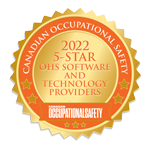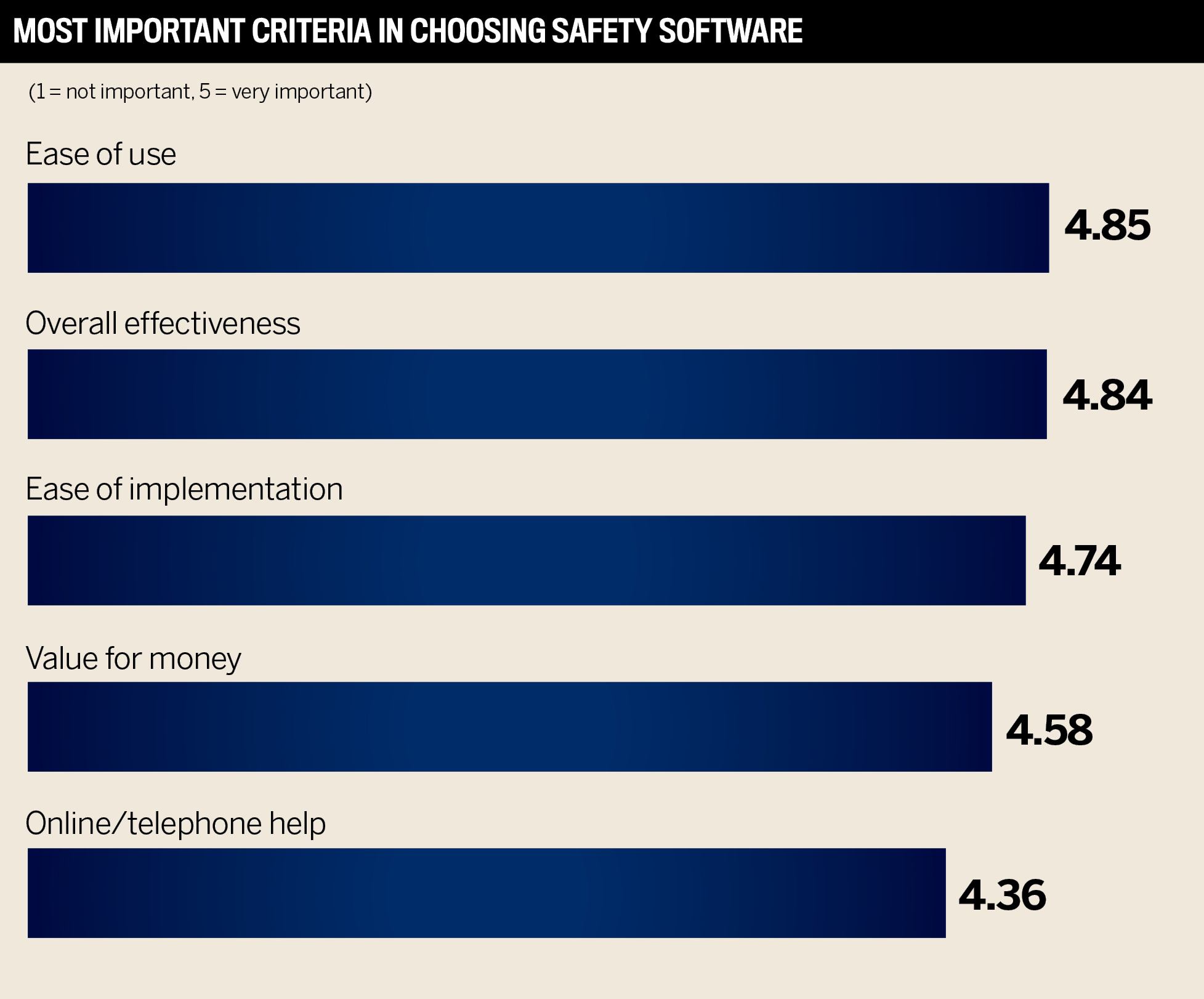

Jump to winners | Jump to methodology
The field of occupational health and safety is wide, affording the opportunity to apply technology in plenty of ways. But all of the tech has one overarching mission.
“The world doesn’t care if a piece of equipment breaks or is damaged, or if a product is lost. But if you harm a human being, then there is a problem. OHS is about people – you can’t tech out the people,” says Christl Aggus, president and chair of the Canadian Society of Safety Engineering (CSSE).
“The solution is unique in that our devices feed data to the cloud in real time as they’re being used. So not only do we protect people in the moment, but that data can also be used by companies to generate insights”
Ed Burton, Blackline Safety
Canadian Occupational Safety (COS) surveyed safety professionals and others in the COS network and awarded 20 companies the 5-Star OHS Software and Technology Provider award for their innovations, which increased and ensured workers’ safety.
And Aggus is clear that tech has a big role to play, adding that it “has helped to reduce the workers’ exposures to hazards by identifying them quickly or by removing them, [saving the workers] from having to interface with that hazard.”

Five-star provider AuditSoft captures all audit tasks in a single, easy-to-navigate workflow and automates administrative activities that consume time and cause errors. Their application helps auditors be up to 60% more efficient, making the audit results more reliable.
“We’re trying to use the power of technology to make some processes in the industry more efficient,” explains Ben Snyman, CEO and founder of AuditSoft. “We try to reduce associated risks and associated costs.”
Based on industry best practice, the company’s technology also delivers a higher standard by improving the quality of the audit output.
“The biggest thing about our software is that we draw data from the audits, which has never been done before. We’re standardizing how that data is captured, and how the evidence is captured, and that supports the audit findings and that is allowing us to gather data,” says Snyman.
“That data can help organizations drive their health and safety performance at a micro level, and it can help organizations and industries to look at that data and drive health and safety improvement, and continuous improvement at a macro level.”
Also a 5-Star OHS Software and Technology Provider is chemical hazard-focused Chemscape Safety Technologies, which offers solutions to make safety data sheets (SDS) easier to manage. Their Chemical Hazard Assessment and Management Program (CHAMP) goes beyond the SDS to interpret the data and explains to workers how to use the chemical. Recently, this tech helped a new mother as she returned to the laboratory she worked in.
“She wanted to know which chemicals she should avoid because she was breastfeeding. And so we’re able to provide the list of chemicals in her workplace that she should avoid to make sure she protects her baby,” says Michael Phibbs, president of Chemscape.
“We know that people aren’t going to read SDSs. What we’ve done is we’ve been able to associate images and icons for PPE, fire extinguishers or others. With those, we’ve automated that process based on risks or hazards present in the workplace.”
Blackline Safety, another 5-Star OHS Software and Technology Provider, manufactures a suite of cloud-connected wearable safety and area gas monitors. They are used primarily to protect workers at risk of exposure to hazardous gases in industrial work sites.
In confined spaces, these devices integrate cellular or satellite connectivity, and location technology with an emergency latch and a variety of sensors to detect gas or slips, trips and falls, or no motion. These tools can call for help, even if workers can’t.
Ed Burton, Blackline Safety’s regional sales manager for Western Canada, says, “The solution is unique in that our devices feed data to the cloud in real time as they’re being used. So not only do we protect people in the moment, but that data can also be used by companies to generate insights.”
He adds, “When it comes to safety technology, customers and investors want to feel confident they’re partnering with organizations that are trusted, reliable and responsive with established track records. Awards like these provide third-party validation of our solutions, and additional proof points on our journey to building credibility and establishing trust within the market space.”
That sentiment about OHS tech providers is echoed by the CSSE’s Aggus, who emphasizes the importance of reputation and expertise.
“If they’re coming up with a new tech and its IT based, they best be having a strong foundation in IT. Brand-new companies may have a great product, but if you haven’t been around for a long time, purchasers are less likely to purchase from you, especially when you’re talking about tech,” she says.
“The biggest thing about our software is that we draw data from the audits, which has never been done before. We’re standardizing how that data is captured, and how the evidence is captured, and that supports the audit findings and that is allowing us to gather data”
Ben Snyman, AuditSoft
Industry expert Dave Rebbitt, CEO of Rarebit Consulting, which provides services across Western Canada, is clear that OHS software and tech providers, such as the 5-Star winners presented in this report, have an opportunity to be relevant in the long term.
“One of the issues that I see is [companies] try to develop their own platform and that sounds like such a good idea, except the development usually involves a small group of people and when any one of those people leaves the company for whatever reason, that hamstrings the software and the ability to use it,” he explains.
“They really should be trying to get something that’s off the shelf that can be upgraded and updated. If you develop something internally, you’re really playing with fire, in my opinion.”
ESG is among the main areas of focus for employers currently, but while most of the attention has been on greenhouse gases and other environmental issues, workers are becoming more prominent. This has been a development for major oil companies in particular, according to Phibbs.
“The shareholders are holding the CEOs accountable for deaths in their workplace. We’re just at the cusp of the ESG starting to focus also on workers.”
Snyman feels ESG will also be a major concern. “The future of occupational health and safety is going to be driven by the whole idea of ESG, GRC and corporate social responsibility, and the ability of organizations to be able to report and prove what they are doing to drive OHS not just within the organization, but also within their supply chains,” he says. “We’ve already seen that and for you to effectively do that, you’re going to need data that’s going to help you manage and mitigate associated risks.”
Another major issue is data privacy. Clients and customers want to know if their data is secure, what information is being collected, how it’s processed and shared, and what the options are for controlling personal information, says Burton.
“This concern is alleviated by modern cloud software and policies, with their strict data and privacy protocols. The most relevant to the challenge of collecting data is ensuring that it’s not being used for purposes that it’s not intended for – which is to keep workers safe, to have key performance indicators measured that you’ve never been able to see before, and have actual, measurable marked improvements on safety programs.”
“We know that people aren’t going to read SDSs. What we’ve done is we’ve been able to associate images and icons for PPE or fire extinguishers or others. With those, we’ve automated that process based on risks or hazards present in the workplace”
Michael Phibbs, Chemscape Safety Technologies

Software and technology have been around for a long time in OHS, enabling employers to have safer workplaces. This relationship is set to continue.
“Technology is going to play specific efficiency roles, to increase efficiency and to protect people at a micro level, at a very job-specific level,” says Snyman.
But even with these tools, employers can never disregard the human role in workplace safety and the need to acquire tech that complements it.
“The human element never goes away because we’re obviously dealing and working with people,” says Burton. “Our products can trigger an alert if workers are at risk, but somebody still needs to be able to respond. It’s always going to be a part of any given solution, whether it’s interpreting the data or responding to an emergency situation.”
In agreement is Robert B. Stewart, president and chief science officer at Intactix Systems. He witnesses firms purchasing expensive tech applications and adds, “Later on they find out that it’s just exacerbated their underlying problem because at the end of the day, safety has been and always will be a people issue. Technology just needs to be a tool. It helps support that, not eliminate the human being.”
In the process of selecting the best safety software and technology providers for 2022, the COS team conducted one-on-one interviews with safety professionals and surveyed hundreds more within the publication’s network to gain a keen understanding of what these professionals think about current market offerings. Respondents were asked to vote for the technology providers they had dealt with across eight categories: contractor management software, fleet management solutions, lone worker technology, SDS management solutions, compliance software, impairment, fatigue detection software, ESG management software, and risk management software.
From there, technology providers were invited to nominate their own products, describe their benefits and explain why they believed their solutions were worthy of a 5-Star award. At the end of the 15-week research period, 20 companies were named 5-Star award winners.
60.5% of respondents typically shortlist 3–5 safety software vendors
27.1% are from mid-size companies (100–999 employees)
15.5% have a buying timeline of 6–12 months